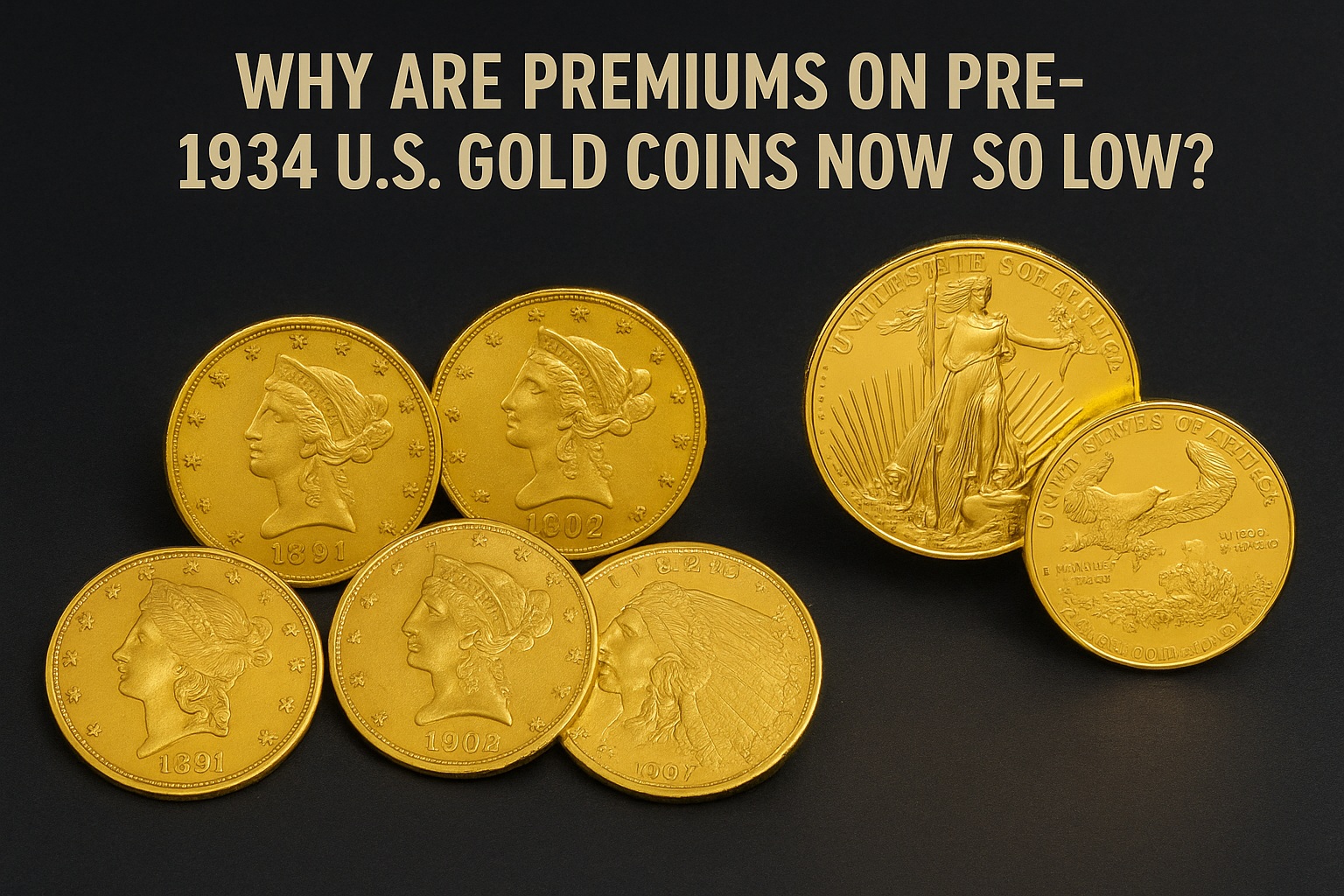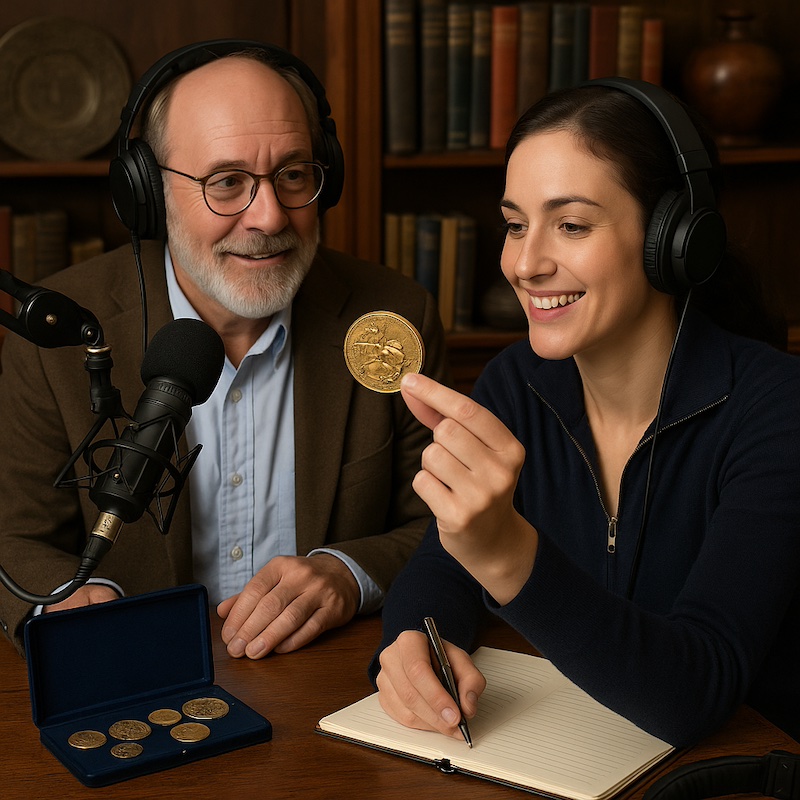The gold market in 2025 has delivered an unexpected twist for numismatists and investors alike: premiums on pre-1934 U.S. gold coins—once a hallmark of collectible value—are now trading near or even below those of standard bullion coins.
For seasoned coin collectors, this is a fascinating (and potentially profitable) anomaly. For investors, it’s a market signal worth paying close attention to.
What’s driving this reversal? How does it affect collecting and investment strategies? And could these historically significant coins be poised for a rebound?
Let’s break down what’s happening and why it matters.
The Market Shift: Gold Up, Premiums Down
Over the past year, the spot price of gold has surged more than 75% since late 2023, fueled by global economic uncertainty, inflation concerns, and central bank buying. Typically, when gold rises sharply, premiums on collectible coins rise too—especially older U.S. issues with historical appeal and limited supply.
Yet, the opposite has occurred. Circulated pre-1934 U.S. gold coins, including:
- $10 Liberty Head Eagles,
- $5 Liberty Head Half Eagles,
- $5 Indian Head Half Eagles, and
- $20 Saint-Gaudens Double Eagles,
are now selling for little more than the intrinsic gold value of modern American Gold Eagle bullion coins of equivalent weight.
In some cases, collectors can buy these older issues for less per ounce than newly minted bullion coins—something virtually unheard of in the last two decades.
Understanding Pre-1934 U.S. Gold Coins
Before 1934, the U.S. Mint struck gold coins intended for circulation. These included the Liberty Head and Indian Head designs, as well as the iconic Saint-Gaudens Double Eagle, widely regarded as one of America’s most beautiful coins.
That era ended when President Franklin D. Roosevelt’s Gold Reserve Act of 1934 outlawed private ownership of most gold coins, leading to widespread government recalls and melting. Millions of pre-1934 coins were lost forever, making survivors both scarce and historically important.
For decades, these coins commanded significant premiums above their melt value due to their:
- Historic provenance (issued before the Gold Recall),
- Design artistry, and
- Relative scarcity compared to modern bullion issues.
So why have premiums collapsed now?
Supply, Demand, and the 2025 Paradox
As Patrick A. Heller—a respected numismatist and communications officer at Liberty Coin Service—explains, today’s lower premiums are driven by simple market mechanics: rising supply and waning demand.
When gold prices rise rapidly, many long-term holders take profits, flooding the market with older coins. At the same time, new buyers often gravitate toward modern bullion products because they are easier to source, trade, and verify.
In short:
- Supply is up: Many owners are liquidating pre-1934 coins.
- Demand is down: Buyers prefer modern bullion coins.
- Result: Premiums have compressed.
Meanwhile, foreign markets, especially in Asia and the Middle East, remain focused on pure bullion gold rather than historical U.S. issues. That means global gold demand isn’t soaking up this excess supply.
Historical Parallels: Lessons from 2008 and Beyond
This isn’t the first time pre-1934 gold coin premiums have declined sharply during a bull market.
- In 2008, when gold first broke $1,000 per ounce, premiums on circulated $20 Liberties briefly fell near melt value. But after the financial crisis deepened and demand for physical gold soared, premiums rebounded dramatically—sometimes doubling or tripling within months.
- In the 1970s and 1980s, similar cycles occurred as collectors shifted between bullion and numismatic products depending on availability and investor sentiment.
History suggests that when gold markets stabilize, collectible premiums often recover, as supply dries up and collectors once again differentiate between historical rarity and raw metal value.
The Case for Collecting Now
For U.S. coin collectors and investors, this market distortion presents a potential buying opportunity.
Why the current environment is favorable:
- Historical Value at Bullion Prices:
You can currently acquire pre-1934 coins—real pieces of American history—at prices near melt value. - Limited Downside, Substantial Upside:
If gold prices fall, numismatic premiums often act as a cushion. If gold stabilizes or rises, premiums may increase again. - Finite Supply:
Once these coins are absorbed by collectors, fewer will remain in dealer inventories. - Diversification Benefits:
Pre-1934 coins combine the intrinsic security of gold bullion with the collectible appeal of historical artifacts.
As Jeff Garrett, past president of the American Numismatic Association, has said:
“Pre-1934 gold is one of the few areas in numismatics where you can still hold genuine 19th- and early 20th-century coins that double as tangible investments. When premiums dip, seasoned collectors take notice.”
The Flip Side: Risks and Considerations
Of course, not every pre-1934 gold coin is a bargain. Buyers should exercise caution and understand the nuances of condition, grading, and authenticity.
Key Risks
- Liquidity: While pre-1934 coins are widely traded, they may not sell as quickly as standard bullion if you need immediate liquidity.
- Grading Variability: Coins graded by PCGS or NGC carry greater resale confidence. Avoid raw or uncertified coins from questionable sources.
- Counterfeits: The market has seen an uptick in sophisticated replicas. Always buy from reputable dealers.
- Market Timing: If gold prices continue to surge, premiums could stay low for longer as more sellers enter the market.
Tip: Look for coins with strong eye appeal and problem-free surfaces. Even circulated examples can hold long-term numismatic potential when acquired at the right price.
Comparing Pre-1934 Gold Coins vs Modern Bullion
| Feature | Pre-1934 U.S. Gold Coins | Modern Bullion Coins (e.g., Gold Eagles) |
|---|---|---|
| Historical Value | High — minted before 1934 Gold Recall | Low — modern issues without circulation history |
| Gold Purity | 90% gold (21.6K) | 91.67% (Gold Eagle) or 99.99% (Buffalo) |
| Premiums (2025) | Low to moderate | Often equal or higher |
| Market Liquidity | Moderate | Very high |
| Collectible Potential | Strong — designs, scarcity, historical appeal | Limited — mostly metal value |
| Best Use | Long-term collectible + bullion hybrid | Pure investment vehicle |
Market Outlook: Could Premiums Rebound?
Many experts believe that the current weakness in premiums is temporary.
Heller himself notes that once the gold price stabilizes—or dips modestly—buyers will likely return to the pre-1934 market. Historically, premium compression often precedes premium expansion, particularly when new investor interest intersects with declining supply.
If the global economy cools or spot gold consolidates, the relative value of these classic coins could rise significantly.
Long-term outlook:
- Short term (3–6 months): Premiums may remain subdued.
- Medium term (6–18 months): Expect stabilization and possible rebound.
- Long term (2+ years): Historical patterns suggest premiums could outpace bullion performance during the next market equilibrium.
TL;DR Summary
- Pre-1934 U.S. gold coins are selling near melt value in 2025.
- Rising gold prices and increased supply have suppressed premiums.
- Demand for modern bullion has overshadowed older numismatic issues.
- Collectors may find opportunity as historical coins trade at bullion-like prices.
- Premiums likely to recover once gold prices stabilize.
FAQs
1. Why are pre-1934 U.S. gold coins cheaper than bullion right now?
Because supply from sellers has increased and collector demand has weakened amid high gold prices, compressing premiums to historic lows.
2. Are these coins still a good investment?
Yes—especially at or near melt value. They offer both intrinsic gold security and collectible potential that may appreciate when premiums recover.
3. Which pre-1934 coins offer the best value?
$20 Liberty and $20 Saint-Gaudens Double Eagles typically offer the most gold for the least premium. $5 and $10 denominations can also be good entry points.
4. Could premiums fall further?
Possibly, if gold continues to rise rapidly and more owners sell. However, sustained lows are unlikely over the long term.
5. Should I buy graded or ungraded coins?
Graded coins (from PCGS or NGC) are preferred for authentication, resale confidence, and protection against counterfeits.
Conclusion: A Time for Strategic Collecting
The unusually low premiums on pre-1934 U.S. gold coins represent a rare window where history, artistry, and intrinsic value align. While modern bullion coins may dominate headlines, pre-1934 issues offer something far richer: a tangible connection to America’s golden age of coinage.
For collectors and investors alike, now may be the time to accumulate—not liquidate—these classic coins while prices remain historically favorable.
As always, due diligence and trusted dealers are key. But for those who understand the cyclical nature of the numismatic market, today’s undervaluation could become tomorrow’s opportunity.








